Compliance with the WHS Acts, Regulations and Codes of Practice
VerifiedAdded on 2023/06/03
|15
|3585
|83
AI Summary
This report outlines the policies enacted in companies, measures and programmes put in place to direct the talk on safety issues with workers, how the risks related are identified and how the assessment of risk outcomes and control are disseminated and implemented. The roles of company leaders and supervisor has also been analysed in order to find out if they comply with the WHS Acts of 2011 and 2012. There are several recommendations for the health hazards and safety risks identified.
Contribute Materials
Your contribution can guide someone’s learning journey. Share your
documents today.
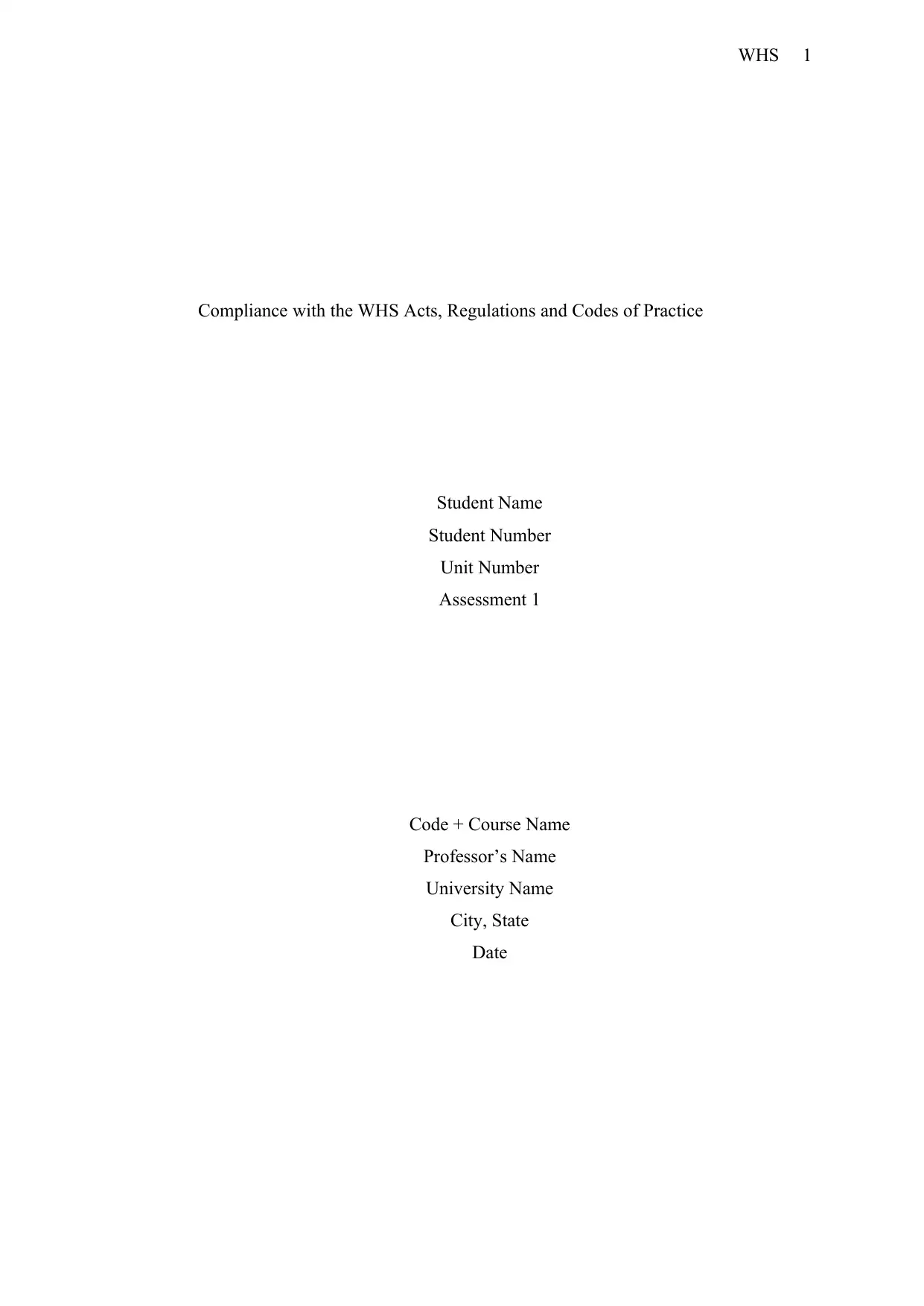
WHS 1
Compliance with the WHS Acts, Regulations and Codes of Practice
Student Name
Student Number
Unit Number
Assessment 1
Code + Course Name
Professor’s Name
University Name
City, State
Date
Compliance with the WHS Acts, Regulations and Codes of Practice
Student Name
Student Number
Unit Number
Assessment 1
Code + Course Name
Professor’s Name
University Name
City, State
Date
Secure Best Marks with AI Grader
Need help grading? Try our AI Grader for instant feedback on your assignments.
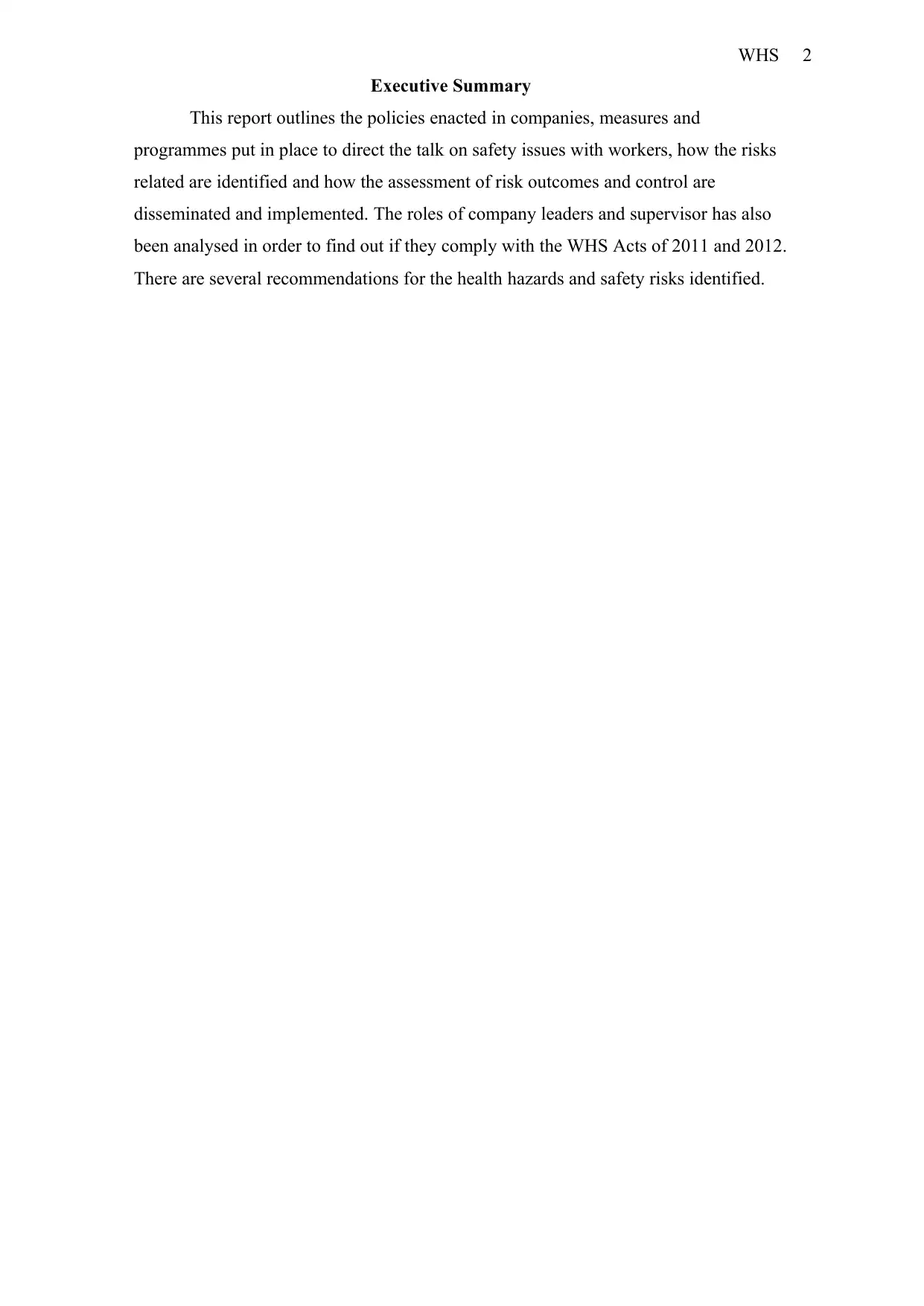
WHS 2
Executive Summary
This report outlines the policies enacted in companies, measures and
programmes put in place to direct the talk on safety issues with workers, how the risks
related are identified and how the assessment of risk outcomes and control are
disseminated and implemented. The roles of company leaders and supervisor has also
been analysed in order to find out if they comply with the WHS Acts of 2011 and 2012.
There are several recommendations for the health hazards and safety risks identified.
Executive Summary
This report outlines the policies enacted in companies, measures and
programmes put in place to direct the talk on safety issues with workers, how the risks
related are identified and how the assessment of risk outcomes and control are
disseminated and implemented. The roles of company leaders and supervisor has also
been analysed in order to find out if they comply with the WHS Acts of 2011 and 2012.
There are several recommendations for the health hazards and safety risks identified.
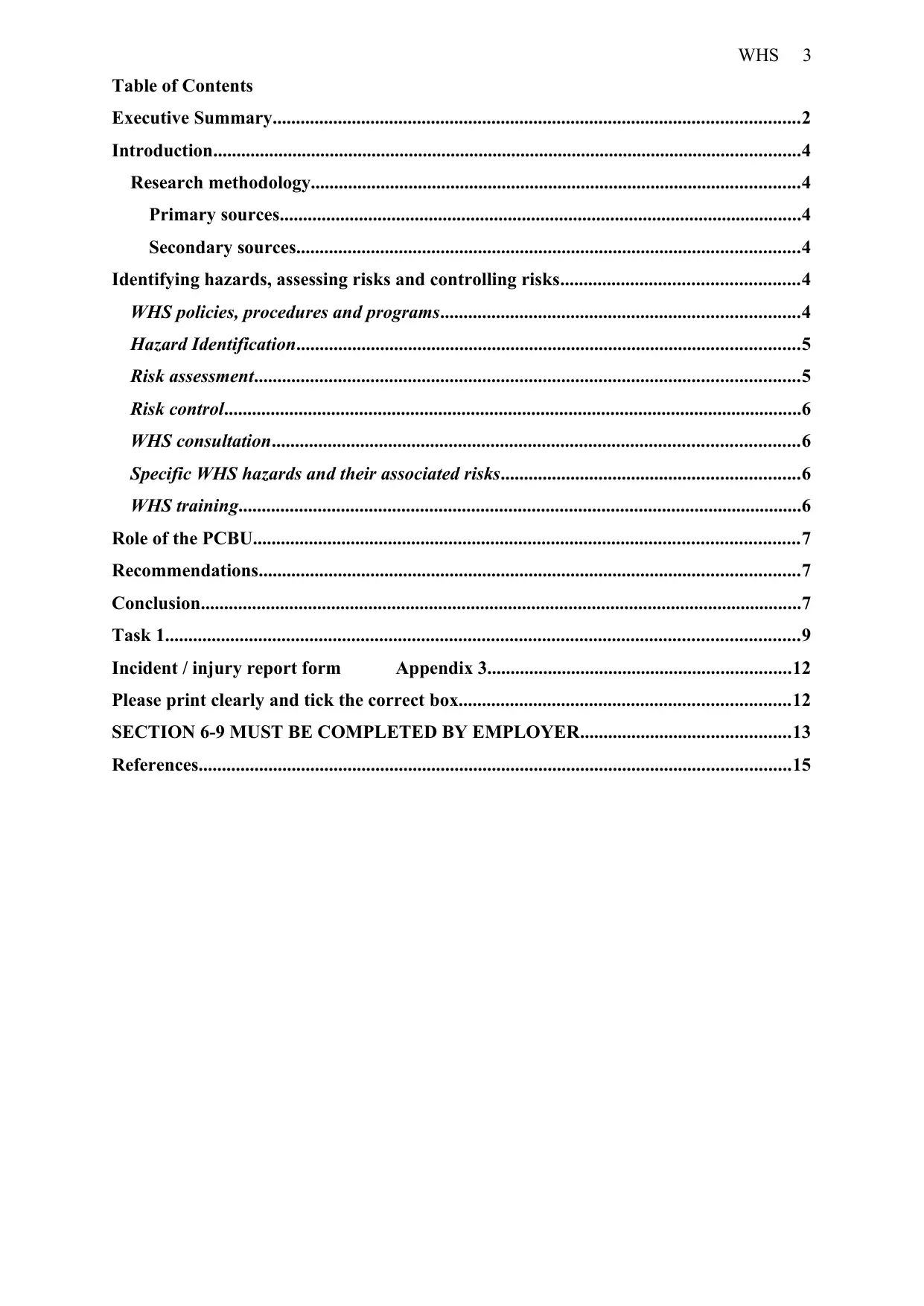
WHS 3
Table of Contents
Executive Summary.................................................................................................................2
Introduction..............................................................................................................................4
Research methodology.........................................................................................................4
Primary sources................................................................................................................4
Secondary sources............................................................................................................4
Identifying hazards, assessing risks and controlling risks...................................................4
WHS policies, procedures and programs.............................................................................4
Hazard Identification............................................................................................................5
Risk assessment.....................................................................................................................5
Risk control............................................................................................................................6
WHS consultation.................................................................................................................6
Specific WHS hazards and their associated risks................................................................6
WHS training.........................................................................................................................6
Role of the PCBU.....................................................................................................................7
Recommendations....................................................................................................................7
Conclusion.................................................................................................................................7
Task 1........................................................................................................................................9
Incident / injury report form Appendix 3.................................................................12
Please print clearly and tick the correct box.......................................................................12
SECTION 6-9 MUST BE COMPLETED BY EMPLOYER.............................................13
References...............................................................................................................................15
Table of Contents
Executive Summary.................................................................................................................2
Introduction..............................................................................................................................4
Research methodology.........................................................................................................4
Primary sources................................................................................................................4
Secondary sources............................................................................................................4
Identifying hazards, assessing risks and controlling risks...................................................4
WHS policies, procedures and programs.............................................................................4
Hazard Identification............................................................................................................5
Risk assessment.....................................................................................................................5
Risk control............................................................................................................................6
WHS consultation.................................................................................................................6
Specific WHS hazards and their associated risks................................................................6
WHS training.........................................................................................................................6
Role of the PCBU.....................................................................................................................7
Recommendations....................................................................................................................7
Conclusion.................................................................................................................................7
Task 1........................................................................................................................................9
Incident / injury report form Appendix 3.................................................................12
Please print clearly and tick the correct box.......................................................................12
SECTION 6-9 MUST BE COMPLETED BY EMPLOYER.............................................13
References...............................................................................................................................15
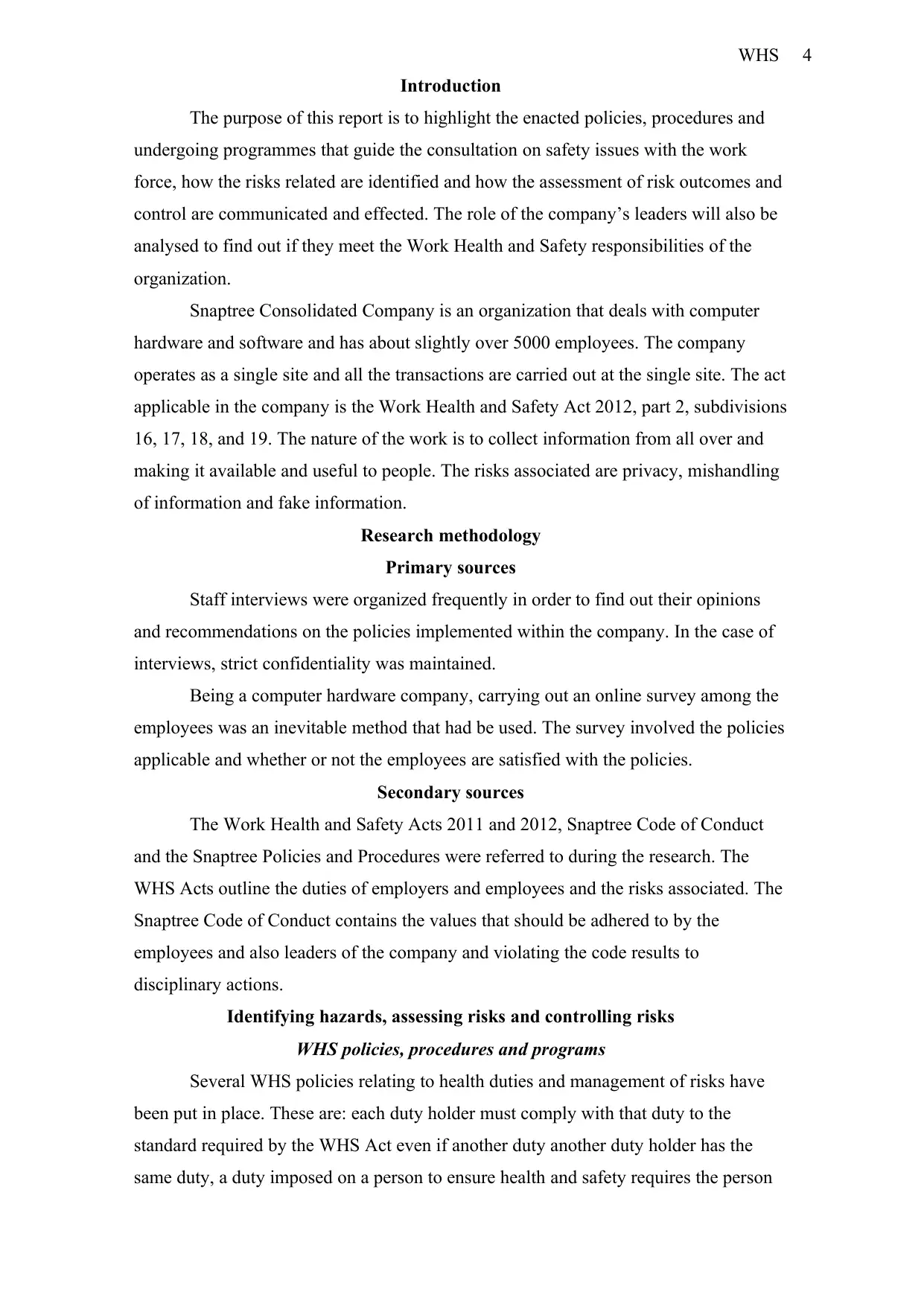
WHS 4
Introduction
The purpose of this report is to highlight the enacted policies, procedures and
undergoing programmes that guide the consultation on safety issues with the work
force, how the risks related are identified and how the assessment of risk outcomes and
control are communicated and effected. The role of the company’s leaders will also be
analysed to find out if they meet the Work Health and Safety responsibilities of the
organization.
Snaptree Consolidated Company is an organization that deals with computer
hardware and software and has about slightly over 5000 employees. The company
operates as a single site and all the transactions are carried out at the single site. The act
applicable in the company is the Work Health and Safety Act 2012, part 2, subdivisions
16, 17, 18, and 19. The nature of the work is to collect information from all over and
making it available and useful to people. The risks associated are privacy, mishandling
of information and fake information.
Research methodology
Primary sources
Staff interviews were organized frequently in order to find out their opinions
and recommendations on the policies implemented within the company. In the case of
interviews, strict confidentiality was maintained.
Being a computer hardware company, carrying out an online survey among the
employees was an inevitable method that had be used. The survey involved the policies
applicable and whether or not the employees are satisfied with the policies.
Secondary sources
The Work Health and Safety Acts 2011 and 2012, Snaptree Code of Conduct
and the Snaptree Policies and Procedures were referred to during the research. The
WHS Acts outline the duties of employers and employees and the risks associated. The
Snaptree Code of Conduct contains the values that should be adhered to by the
employees and also leaders of the company and violating the code results to
disciplinary actions.
Identifying hazards, assessing risks and controlling risks
WHS policies, procedures and programs
Several WHS policies relating to health duties and management of risks have
been put in place. These are: each duty holder must comply with that duty to the
standard required by the WHS Act even if another duty another duty holder has the
same duty, a duty imposed on a person to ensure health and safety requires the person
Introduction
The purpose of this report is to highlight the enacted policies, procedures and
undergoing programmes that guide the consultation on safety issues with the work
force, how the risks related are identified and how the assessment of risk outcomes and
control are communicated and effected. The role of the company’s leaders will also be
analysed to find out if they meet the Work Health and Safety responsibilities of the
organization.
Snaptree Consolidated Company is an organization that deals with computer
hardware and software and has about slightly over 5000 employees. The company
operates as a single site and all the transactions are carried out at the single site. The act
applicable in the company is the Work Health and Safety Act 2012, part 2, subdivisions
16, 17, 18, and 19. The nature of the work is to collect information from all over and
making it available and useful to people. The risks associated are privacy, mishandling
of information and fake information.
Research methodology
Primary sources
Staff interviews were organized frequently in order to find out their opinions
and recommendations on the policies implemented within the company. In the case of
interviews, strict confidentiality was maintained.
Being a computer hardware company, carrying out an online survey among the
employees was an inevitable method that had be used. The survey involved the policies
applicable and whether or not the employees are satisfied with the policies.
Secondary sources
The Work Health and Safety Acts 2011 and 2012, Snaptree Code of Conduct
and the Snaptree Policies and Procedures were referred to during the research. The
WHS Acts outline the duties of employers and employees and the risks associated. The
Snaptree Code of Conduct contains the values that should be adhered to by the
employees and also leaders of the company and violating the code results to
disciplinary actions.
Identifying hazards, assessing risks and controlling risks
WHS policies, procedures and programs
Several WHS policies relating to health duties and management of risks have
been put in place. These are: each duty holder must comply with that duty to the
standard required by the WHS Act even if another duty another duty holder has the
same duty, a duty imposed on a person to ensure health and safety requires the person
Paraphrase This Document
Need a fresh take? Get an instant paraphrase of this document with our AI Paraphraser
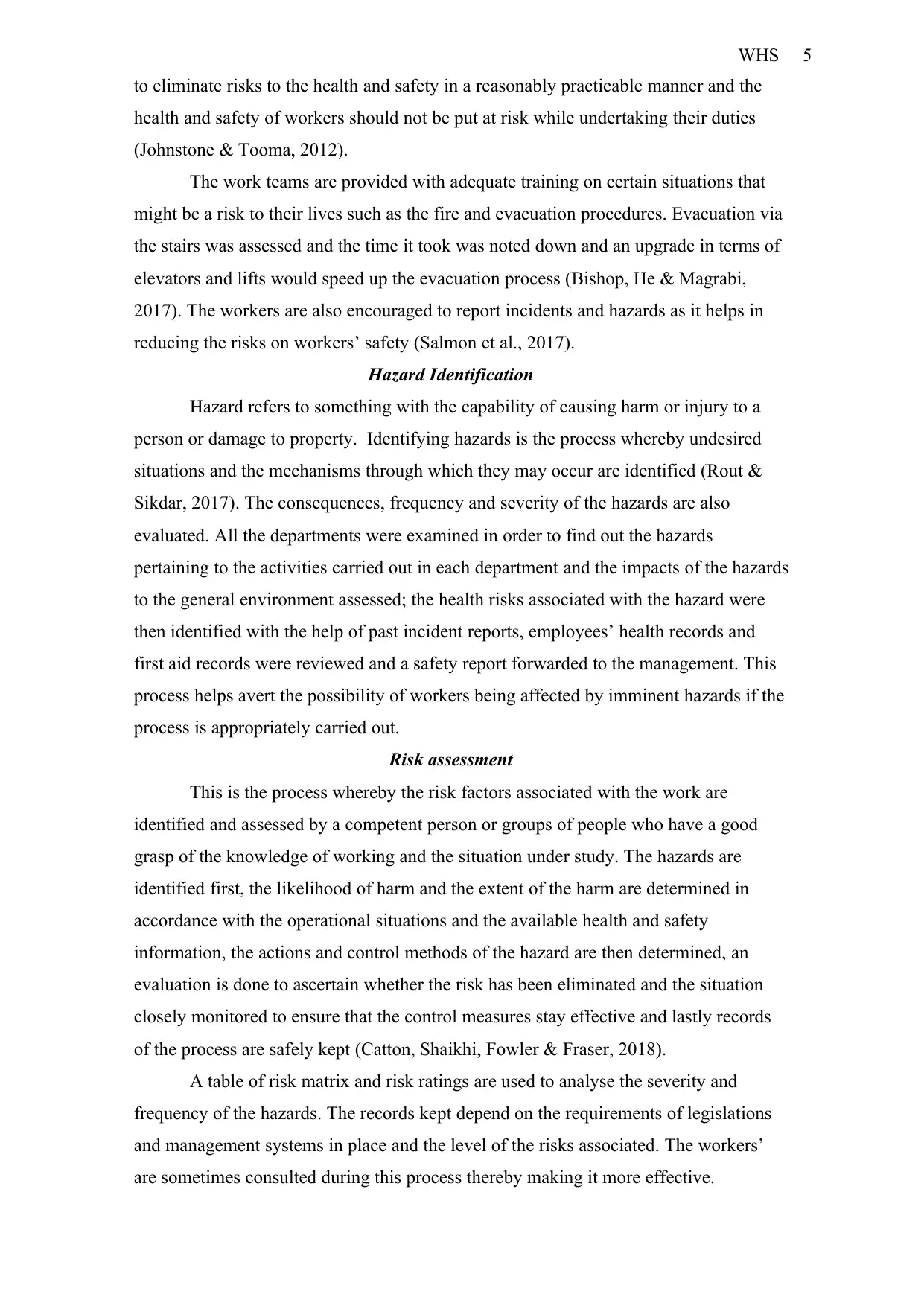
WHS 5
to eliminate risks to the health and safety in a reasonably practicable manner and the
health and safety of workers should not be put at risk while undertaking their duties
(Johnstone & Tooma, 2012).
The work teams are provided with adequate training on certain situations that
might be a risk to their lives such as the fire and evacuation procedures. Evacuation via
the stairs was assessed and the time it took was noted down and an upgrade in terms of
elevators and lifts would speed up the evacuation process (Bishop, He & Magrabi,
2017). The workers are also encouraged to report incidents and hazards as it helps in
reducing the risks on workers’ safety (Salmon et al., 2017).
Hazard Identification
Hazard refers to something with the capability of causing harm or injury to a
person or damage to property. Identifying hazards is the process whereby undesired
situations and the mechanisms through which they may occur are identified (Rout &
Sikdar, 2017). The consequences, frequency and severity of the hazards are also
evaluated. All the departments were examined in order to find out the hazards
pertaining to the activities carried out in each department and the impacts of the hazards
to the general environment assessed; the health risks associated with the hazard were
then identified with the help of past incident reports, employees’ health records and
first aid records were reviewed and a safety report forwarded to the management. This
process helps avert the possibility of workers being affected by imminent hazards if the
process is appropriately carried out.
Risk assessment
This is the process whereby the risk factors associated with the work are
identified and assessed by a competent person or groups of people who have a good
grasp of the knowledge of working and the situation under study. The hazards are
identified first, the likelihood of harm and the extent of the harm are determined in
accordance with the operational situations and the available health and safety
information, the actions and control methods of the hazard are then determined, an
evaluation is done to ascertain whether the risk has been eliminated and the situation
closely monitored to ensure that the control measures stay effective and lastly records
of the process are safely kept (Catton, Shaikhi, Fowler & Fraser, 2018).
A table of risk matrix and risk ratings are used to analyse the severity and
frequency of the hazards. The records kept depend on the requirements of legislations
and management systems in place and the level of the risks associated. The workers’
are sometimes consulted during this process thereby making it more effective.
to eliminate risks to the health and safety in a reasonably practicable manner and the
health and safety of workers should not be put at risk while undertaking their duties
(Johnstone & Tooma, 2012).
The work teams are provided with adequate training on certain situations that
might be a risk to their lives such as the fire and evacuation procedures. Evacuation via
the stairs was assessed and the time it took was noted down and an upgrade in terms of
elevators and lifts would speed up the evacuation process (Bishop, He & Magrabi,
2017). The workers are also encouraged to report incidents and hazards as it helps in
reducing the risks on workers’ safety (Salmon et al., 2017).
Hazard Identification
Hazard refers to something with the capability of causing harm or injury to a
person or damage to property. Identifying hazards is the process whereby undesired
situations and the mechanisms through which they may occur are identified (Rout &
Sikdar, 2017). The consequences, frequency and severity of the hazards are also
evaluated. All the departments were examined in order to find out the hazards
pertaining to the activities carried out in each department and the impacts of the hazards
to the general environment assessed; the health risks associated with the hazard were
then identified with the help of past incident reports, employees’ health records and
first aid records were reviewed and a safety report forwarded to the management. This
process helps avert the possibility of workers being affected by imminent hazards if the
process is appropriately carried out.
Risk assessment
This is the process whereby the risk factors associated with the work are
identified and assessed by a competent person or groups of people who have a good
grasp of the knowledge of working and the situation under study. The hazards are
identified first, the likelihood of harm and the extent of the harm are determined in
accordance with the operational situations and the available health and safety
information, the actions and control methods of the hazard are then determined, an
evaluation is done to ascertain whether the risk has been eliminated and the situation
closely monitored to ensure that the control measures stay effective and lastly records
of the process are safely kept (Catton, Shaikhi, Fowler & Fraser, 2018).
A table of risk matrix and risk ratings are used to analyse the severity and
frequency of the hazards. The records kept depend on the requirements of legislations
and management systems in place and the level of the risks associated. The workers’
are sometimes consulted during this process thereby making it more effective.
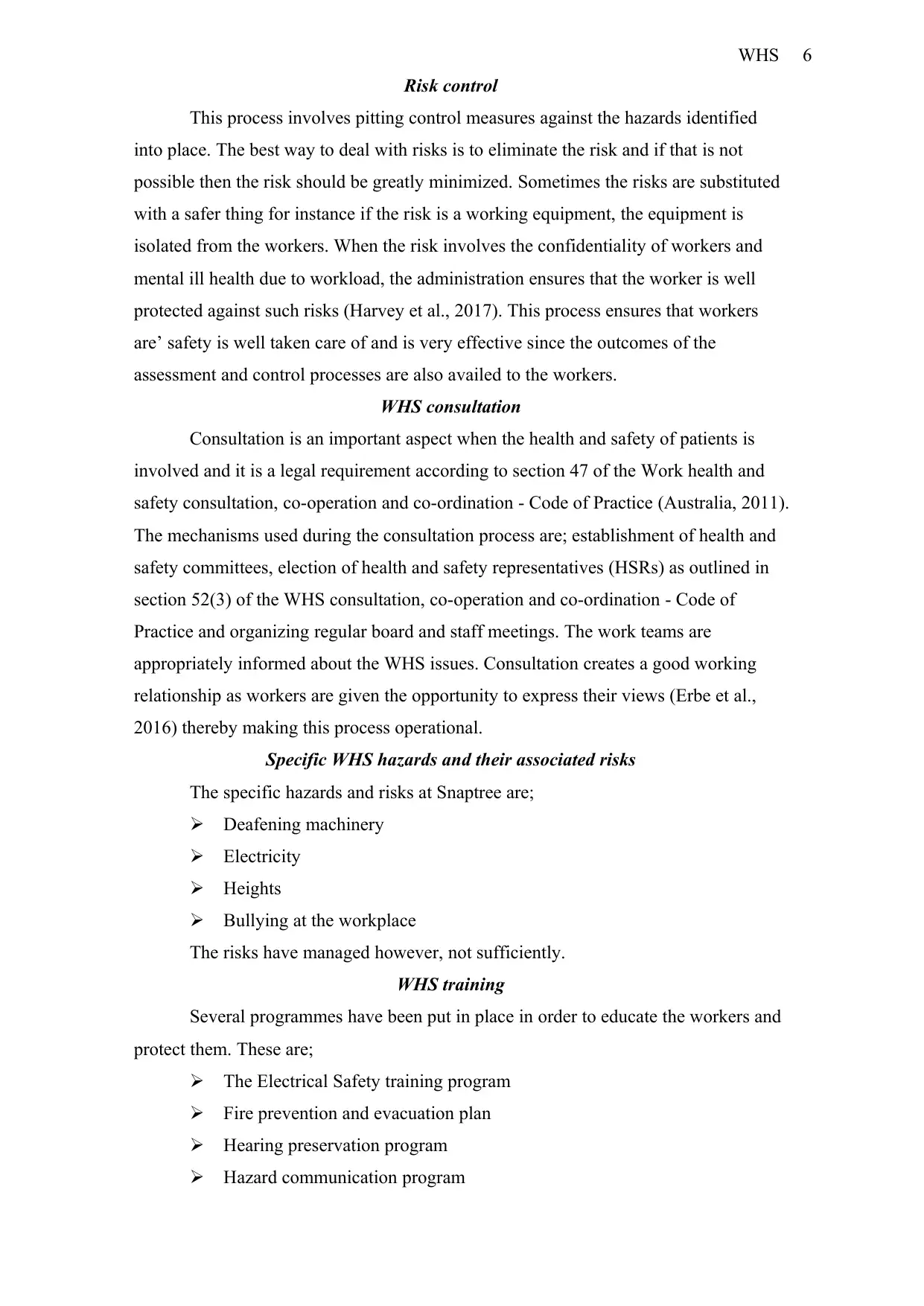
WHS 6
Risk control
This process involves pitting control measures against the hazards identified
into place. The best way to deal with risks is to eliminate the risk and if that is not
possible then the risk should be greatly minimized. Sometimes the risks are substituted
with a safer thing for instance if the risk is a working equipment, the equipment is
isolated from the workers. When the risk involves the confidentiality of workers and
mental ill health due to workload, the administration ensures that the worker is well
protected against such risks (Harvey et al., 2017). This process ensures that workers
are’ safety is well taken care of and is very effective since the outcomes of the
assessment and control processes are also availed to the workers.
WHS consultation
Consultation is an important aspect when the health and safety of patients is
involved and it is a legal requirement according to section 47 of the Work health and
safety consultation, co-operation and co-ordination - Code of Practice (Australia, 2011).
The mechanisms used during the consultation process are; establishment of health and
safety committees, election of health and safety representatives (HSRs) as outlined in
section 52(3) of the WHS consultation, co-operation and co-ordination - Code of
Practice and organizing regular board and staff meetings. The work teams are
appropriately informed about the WHS issues. Consultation creates a good working
relationship as workers are given the opportunity to express their views (Erbe et al.,
2016) thereby making this process operational.
Specific WHS hazards and their associated risks
The specific hazards and risks at Snaptree are;
Deafening machinery
Electricity
Heights
Bullying at the workplace
The risks have managed however, not sufficiently.
WHS training
Several programmes have been put in place in order to educate the workers and
protect them. These are;
The Electrical Safety training program
Fire prevention and evacuation plan
Hearing preservation program
Hazard communication program
Risk control
This process involves pitting control measures against the hazards identified
into place. The best way to deal with risks is to eliminate the risk and if that is not
possible then the risk should be greatly minimized. Sometimes the risks are substituted
with a safer thing for instance if the risk is a working equipment, the equipment is
isolated from the workers. When the risk involves the confidentiality of workers and
mental ill health due to workload, the administration ensures that the worker is well
protected against such risks (Harvey et al., 2017). This process ensures that workers
are’ safety is well taken care of and is very effective since the outcomes of the
assessment and control processes are also availed to the workers.
WHS consultation
Consultation is an important aspect when the health and safety of patients is
involved and it is a legal requirement according to section 47 of the Work health and
safety consultation, co-operation and co-ordination - Code of Practice (Australia, 2011).
The mechanisms used during the consultation process are; establishment of health and
safety committees, election of health and safety representatives (HSRs) as outlined in
section 52(3) of the WHS consultation, co-operation and co-ordination - Code of
Practice and organizing regular board and staff meetings. The work teams are
appropriately informed about the WHS issues. Consultation creates a good working
relationship as workers are given the opportunity to express their views (Erbe et al.,
2016) thereby making this process operational.
Specific WHS hazards and their associated risks
The specific hazards and risks at Snaptree are;
Deafening machinery
Electricity
Heights
Bullying at the workplace
The risks have managed however, not sufficiently.
WHS training
Several programmes have been put in place in order to educate the workers and
protect them. These are;
The Electrical Safety training program
Fire prevention and evacuation plan
Hearing preservation program
Hazard communication program
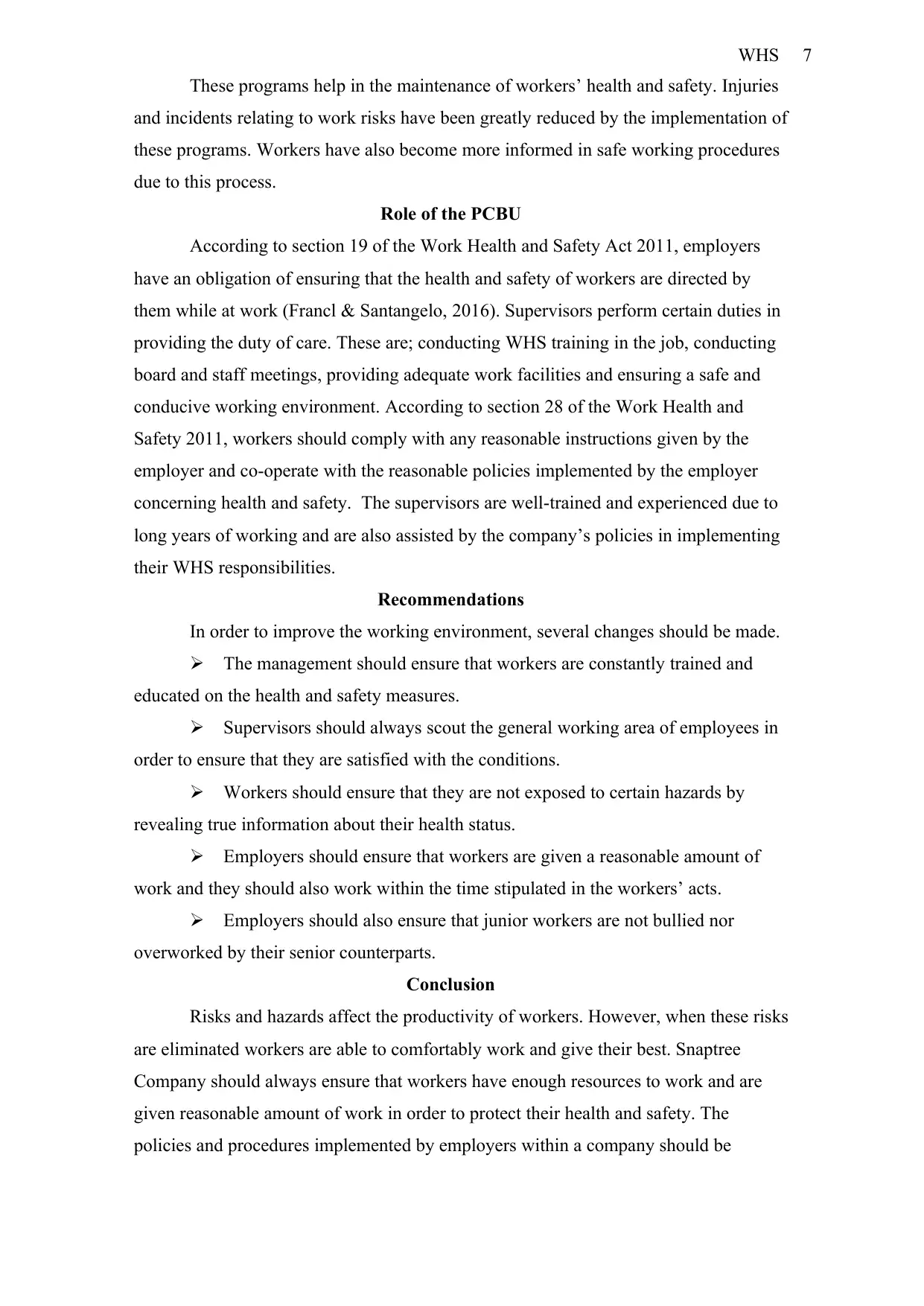
WHS 7
These programs help in the maintenance of workers’ health and safety. Injuries
and incidents relating to work risks have been greatly reduced by the implementation of
these programs. Workers have also become more informed in safe working procedures
due to this process.
Role of the PCBU
According to section 19 of the Work Health and Safety Act 2011, employers
have an obligation of ensuring that the health and safety of workers are directed by
them while at work (Francl & Santangelo, 2016). Supervisors perform certain duties in
providing the duty of care. These are; conducting WHS training in the job, conducting
board and staff meetings, providing adequate work facilities and ensuring a safe and
conducive working environment. According to section 28 of the Work Health and
Safety 2011, workers should comply with any reasonable instructions given by the
employer and co-operate with the reasonable policies implemented by the employer
concerning health and safety. The supervisors are well-trained and experienced due to
long years of working and are also assisted by the company’s policies in implementing
their WHS responsibilities.
Recommendations
In order to improve the working environment, several changes should be made.
The management should ensure that workers are constantly trained and
educated on the health and safety measures.
Supervisors should always scout the general working area of employees in
order to ensure that they are satisfied with the conditions.
Workers should ensure that they are not exposed to certain hazards by
revealing true information about their health status.
Employers should ensure that workers are given a reasonable amount of
work and they should also work within the time stipulated in the workers’ acts.
Employers should also ensure that junior workers are not bullied nor
overworked by their senior counterparts.
Conclusion
Risks and hazards affect the productivity of workers. However, when these risks
are eliminated workers are able to comfortably work and give their best. Snaptree
Company should always ensure that workers have enough resources to work and are
given reasonable amount of work in order to protect their health and safety. The
policies and procedures implemented by employers within a company should be
These programs help in the maintenance of workers’ health and safety. Injuries
and incidents relating to work risks have been greatly reduced by the implementation of
these programs. Workers have also become more informed in safe working procedures
due to this process.
Role of the PCBU
According to section 19 of the Work Health and Safety Act 2011, employers
have an obligation of ensuring that the health and safety of workers are directed by
them while at work (Francl & Santangelo, 2016). Supervisors perform certain duties in
providing the duty of care. These are; conducting WHS training in the job, conducting
board and staff meetings, providing adequate work facilities and ensuring a safe and
conducive working environment. According to section 28 of the Work Health and
Safety 2011, workers should comply with any reasonable instructions given by the
employer and co-operate with the reasonable policies implemented by the employer
concerning health and safety. The supervisors are well-trained and experienced due to
long years of working and are also assisted by the company’s policies in implementing
their WHS responsibilities.
Recommendations
In order to improve the working environment, several changes should be made.
The management should ensure that workers are constantly trained and
educated on the health and safety measures.
Supervisors should always scout the general working area of employees in
order to ensure that they are satisfied with the conditions.
Workers should ensure that they are not exposed to certain hazards by
revealing true information about their health status.
Employers should ensure that workers are given a reasonable amount of
work and they should also work within the time stipulated in the workers’ acts.
Employers should also ensure that junior workers are not bullied nor
overworked by their senior counterparts.
Conclusion
Risks and hazards affect the productivity of workers. However, when these risks
are eliminated workers are able to comfortably work and give their best. Snaptree
Company should always ensure that workers have enough resources to work and are
given reasonable amount of work in order to protect their health and safety. The
policies and procedures implemented by employers within a company should be
Secure Best Marks with AI Grader
Need help grading? Try our AI Grader for instant feedback on your assignments.
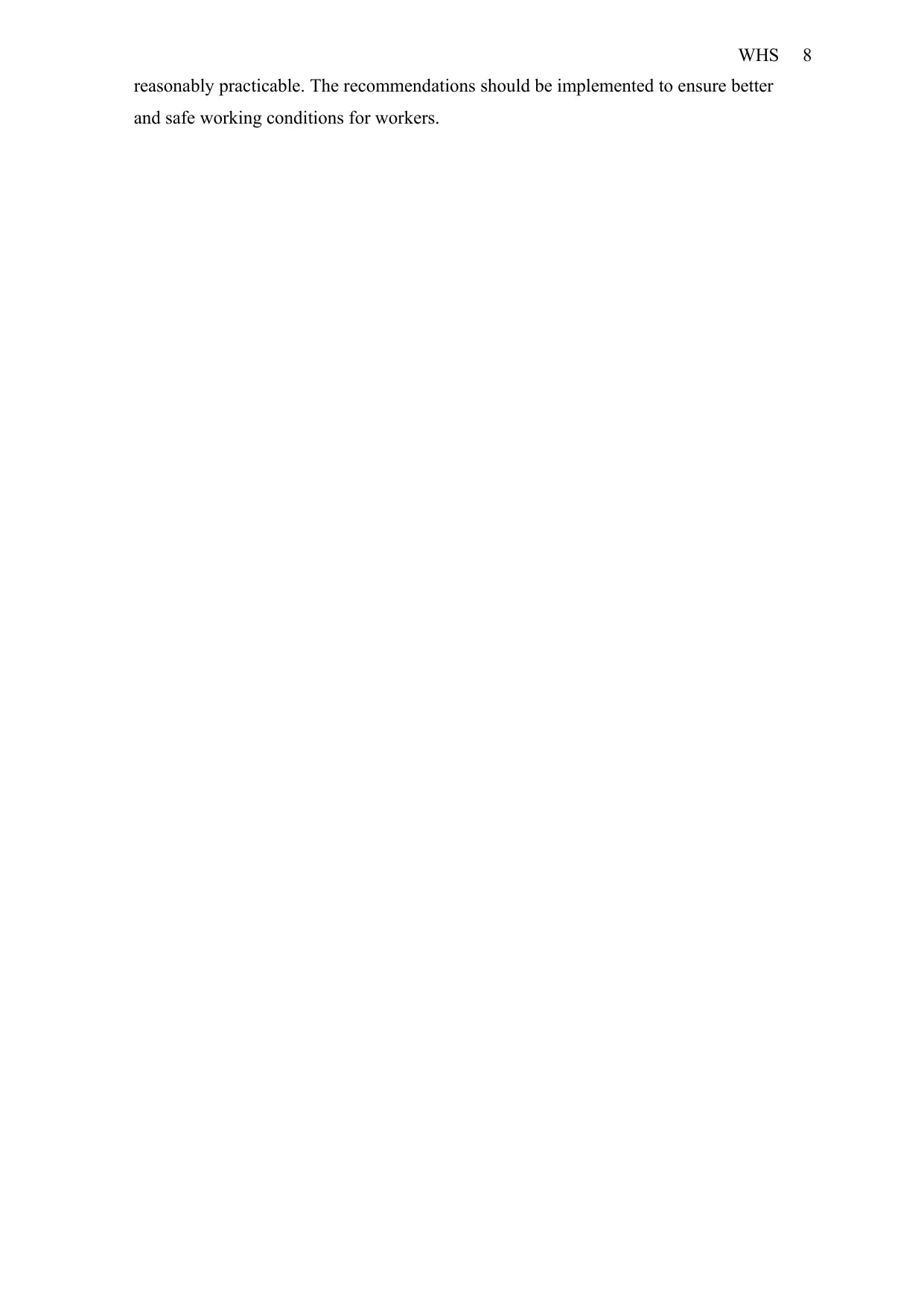
WHS 8
reasonably practicable. The recommendations should be implemented to ensure better
and safe working conditions for workers.
reasonably practicable. The recommendations should be implemented to ensure better
and safe working conditions for workers.
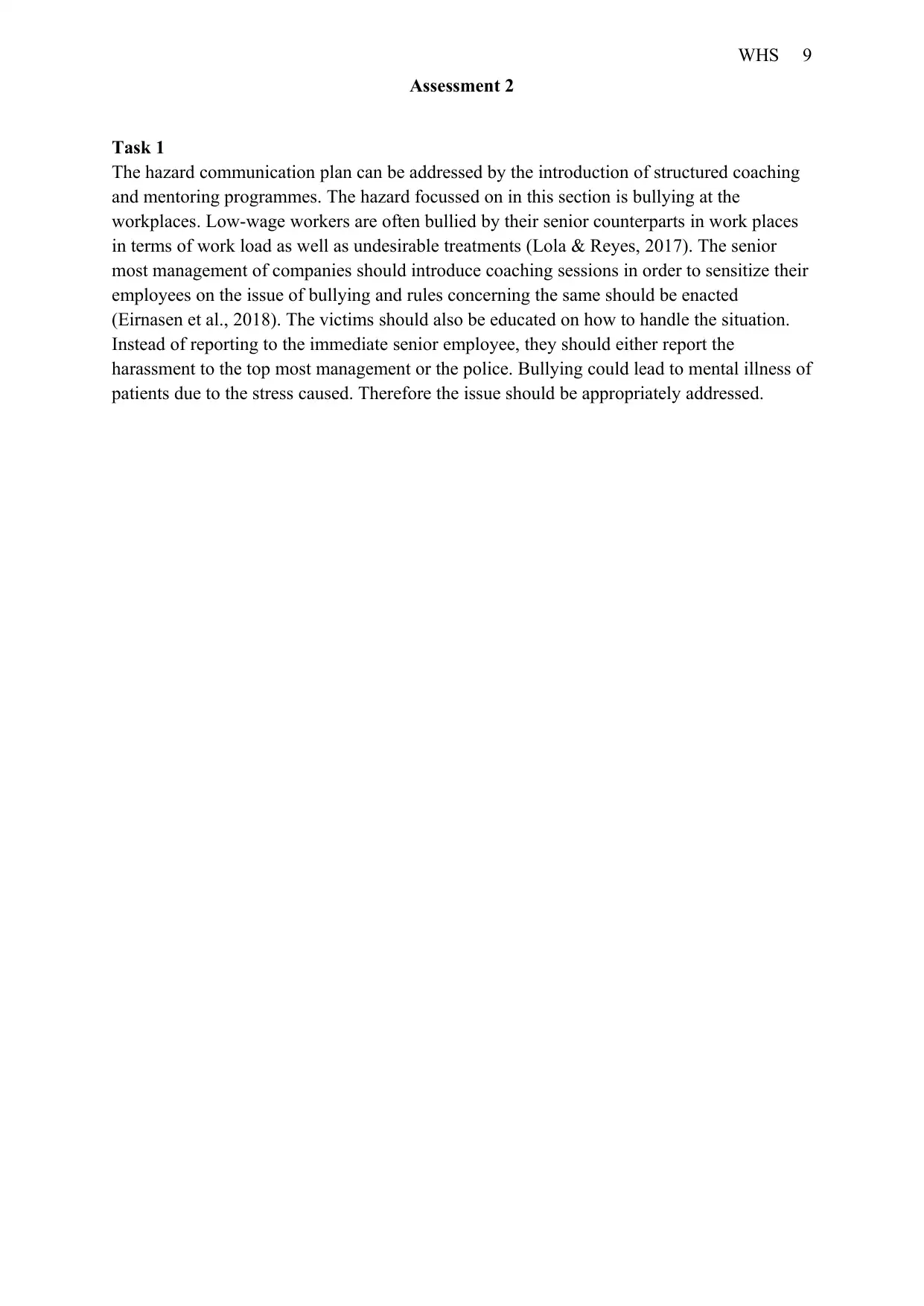
WHS 9
Assessment 2
Task 1
The hazard communication plan can be addressed by the introduction of structured coaching
and mentoring programmes. The hazard focussed on in this section is bullying at the
workplaces. Low-wage workers are often bullied by their senior counterparts in work places
in terms of work load as well as undesirable treatments (Lola & Reyes, 2017). The senior
most management of companies should introduce coaching sessions in order to sensitize their
employees on the issue of bullying and rules concerning the same should be enacted
(Eirnasen et al., 2018). The victims should also be educated on how to handle the situation.
Instead of reporting to the immediate senior employee, they should either report the
harassment to the top most management or the police. Bullying could lead to mental illness of
patients due to the stress caused. Therefore the issue should be appropriately addressed.
Assessment 2
Task 1
The hazard communication plan can be addressed by the introduction of structured coaching
and mentoring programmes. The hazard focussed on in this section is bullying at the
workplaces. Low-wage workers are often bullied by their senior counterparts in work places
in terms of work load as well as undesirable treatments (Lola & Reyes, 2017). The senior
most management of companies should introduce coaching sessions in order to sensitize their
employees on the issue of bullying and rules concerning the same should be enacted
(Eirnasen et al., 2018). The victims should also be educated on how to handle the situation.
Instead of reporting to the immediate senior employee, they should either report the
harassment to the top most management or the police. Bullying could lead to mental illness of
patients due to the stress caused. Therefore the issue should be appropriately addressed.
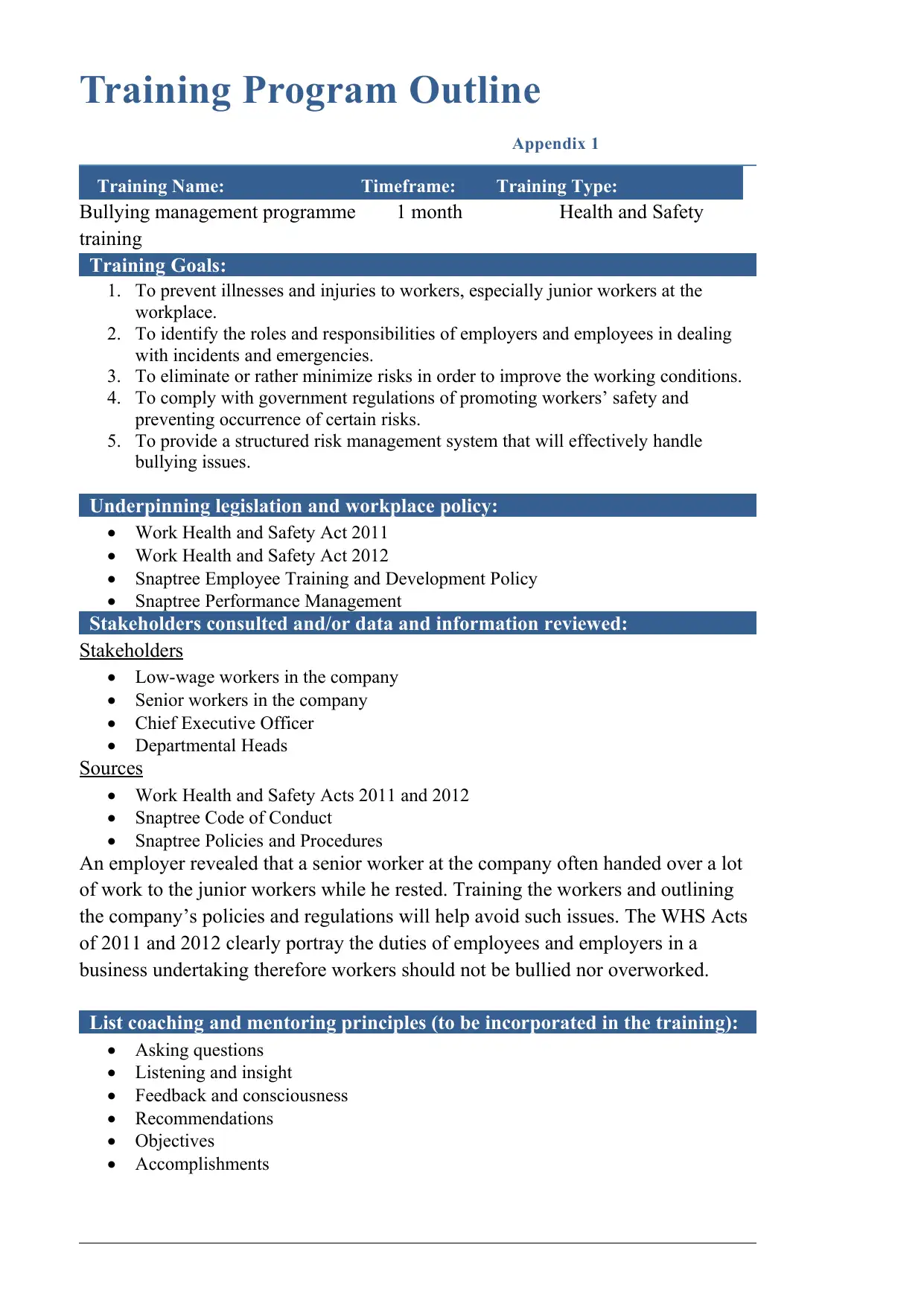
Training Program Outline
Appendix 1
Training Name: Timeframe: Training Type:
Bullying management programme 1 month Health and Safety
training
Training Goals:
1. To prevent illnesses and injuries to workers, especially junior workers at the
workplace.
2. To identify the roles and responsibilities of employers and employees in dealing
with incidents and emergencies.
3. To eliminate or rather minimize risks in order to improve the working conditions.
4. To comply with government regulations of promoting workers’ safety and
preventing occurrence of certain risks.
5. To provide a structured risk management system that will effectively handle
bullying issues.
Underpinning legislation and workplace policy:
Work Health and Safety Act 2011
Work Health and Safety Act 2012
Snaptree Employee Training and Development Policy
Snaptree Performance Management
Stakeholders consulted and/or data and information reviewed:
Stakeholders
Low-wage workers in the company
Senior workers in the company
Chief Executive Officer
Departmental Heads
Sources
Work Health and Safety Acts 2011 and 2012
Snaptree Code of Conduct
Snaptree Policies and Procedures
An employer revealed that a senior worker at the company often handed over a lot
of work to the junior workers while he rested. Training the workers and outlining
the company’s policies and regulations will help avoid such issues. The WHS Acts
of 2011 and 2012 clearly portray the duties of employees and employers in a
business undertaking therefore workers should not be bullied nor overworked.
List coaching and mentoring principles (to be incorporated in the training):
Asking questions
Listening and insight
Feedback and consciousness
Recommendations
Objectives
Accomplishments
Appendix 1
Training Name: Timeframe: Training Type:
Bullying management programme 1 month Health and Safety
training
Training Goals:
1. To prevent illnesses and injuries to workers, especially junior workers at the
workplace.
2. To identify the roles and responsibilities of employers and employees in dealing
with incidents and emergencies.
3. To eliminate or rather minimize risks in order to improve the working conditions.
4. To comply with government regulations of promoting workers’ safety and
preventing occurrence of certain risks.
5. To provide a structured risk management system that will effectively handle
bullying issues.
Underpinning legislation and workplace policy:
Work Health and Safety Act 2011
Work Health and Safety Act 2012
Snaptree Employee Training and Development Policy
Snaptree Performance Management
Stakeholders consulted and/or data and information reviewed:
Stakeholders
Low-wage workers in the company
Senior workers in the company
Chief Executive Officer
Departmental Heads
Sources
Work Health and Safety Acts 2011 and 2012
Snaptree Code of Conduct
Snaptree Policies and Procedures
An employer revealed that a senior worker at the company often handed over a lot
of work to the junior workers while he rested. Training the workers and outlining
the company’s policies and regulations will help avoid such issues. The WHS Acts
of 2011 and 2012 clearly portray the duties of employees and employers in a
business undertaking therefore workers should not be bullied nor overworked.
List coaching and mentoring principles (to be incorporated in the training):
Asking questions
Listening and insight
Feedback and consciousness
Recommendations
Objectives
Accomplishments
Paraphrase This Document
Need a fresh take? Get an instant paraphrase of this document with our AI Paraphraser
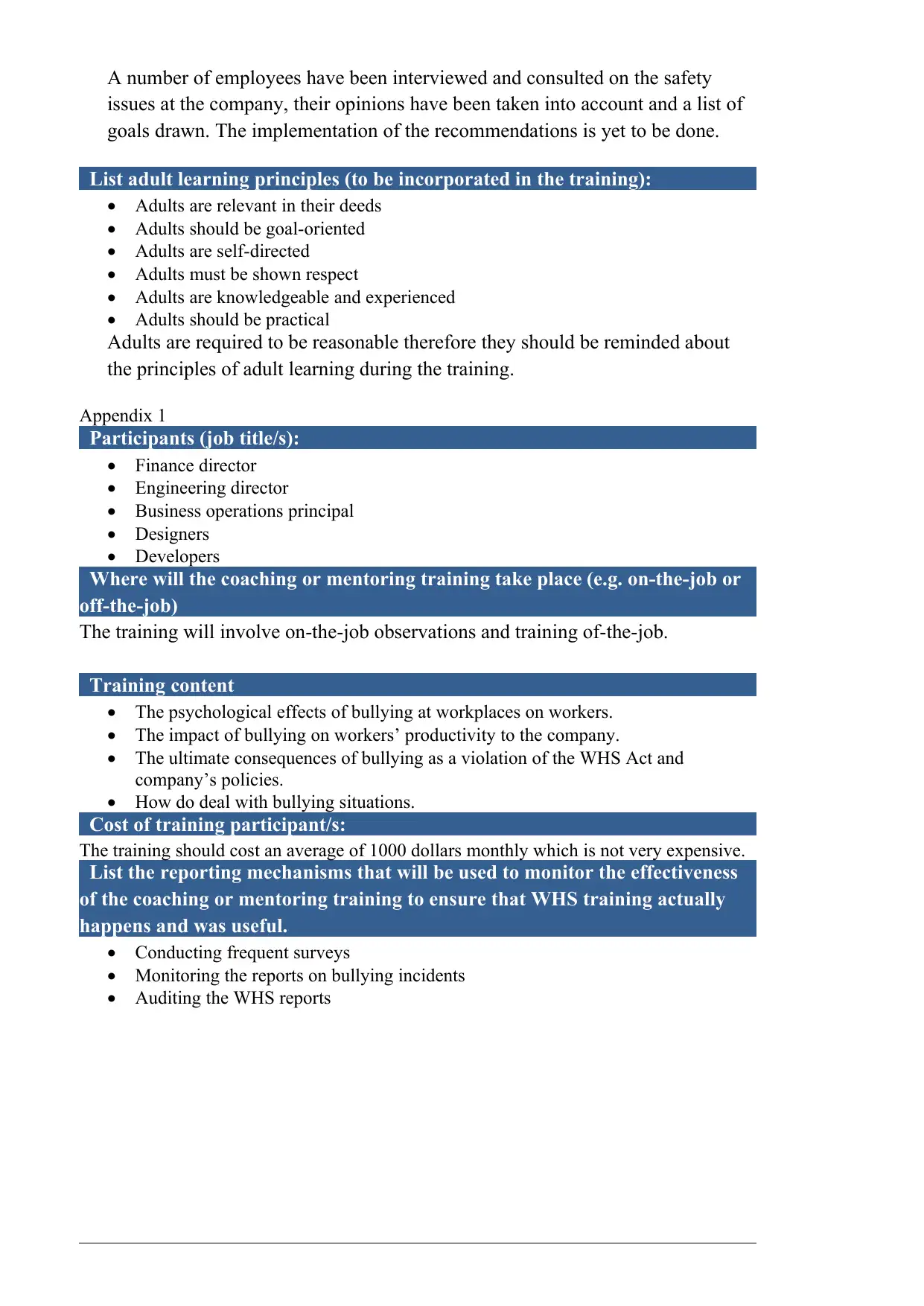
A number of employees have been interviewed and consulted on the safety
issues at the company, their opinions have been taken into account and a list of
goals drawn. The implementation of the recommendations is yet to be done.
List adult learning principles (to be incorporated in the training):
Adults are relevant in their deeds
Adults should be goal-oriented
Adults are self-directed
Adults must be shown respect
Adults are knowledgeable and experienced
Adults should be practical
Adults are required to be reasonable therefore they should be reminded about
the principles of adult learning during the training.
Appendix 1
Participants (job title/s):
Finance director
Engineering director
Business operations principal
Designers
Developers
Where will the coaching or mentoring training take place (e.g. on-the-job or
off-the-job)
The training will involve on-the-job observations and training of-the-job.
Training content
The psychological effects of bullying at workplaces on workers.
The impact of bullying on workers’ productivity to the company.
The ultimate consequences of bullying as a violation of the WHS Act and
company’s policies.
How do deal with bullying situations.
Cost of training participant/s:
The training should cost an average of 1000 dollars monthly which is not very expensive.
List the reporting mechanisms that will be used to monitor the effectiveness
of the coaching or mentoring training to ensure that WHS training actually
happens and was useful.
Conducting frequent surveys
Monitoring the reports on bullying incidents
Auditing the WHS reports
issues at the company, their opinions have been taken into account and a list of
goals drawn. The implementation of the recommendations is yet to be done.
List adult learning principles (to be incorporated in the training):
Adults are relevant in their deeds
Adults should be goal-oriented
Adults are self-directed
Adults must be shown respect
Adults are knowledgeable and experienced
Adults should be practical
Adults are required to be reasonable therefore they should be reminded about
the principles of adult learning during the training.
Appendix 1
Participants (job title/s):
Finance director
Engineering director
Business operations principal
Designers
Developers
Where will the coaching or mentoring training take place (e.g. on-the-job or
off-the-job)
The training will involve on-the-job observations and training of-the-job.
Training content
The psychological effects of bullying at workplaces on workers.
The impact of bullying on workers’ productivity to the company.
The ultimate consequences of bullying as a violation of the WHS Act and
company’s policies.
How do deal with bullying situations.
Cost of training participant/s:
The training should cost an average of 1000 dollars monthly which is not very expensive.
List the reporting mechanisms that will be used to monitor the effectiveness
of the coaching or mentoring training to ensure that WHS training actually
happens and was useful.
Conducting frequent surveys
Monitoring the reports on bullying incidents
Auditing the WHS reports
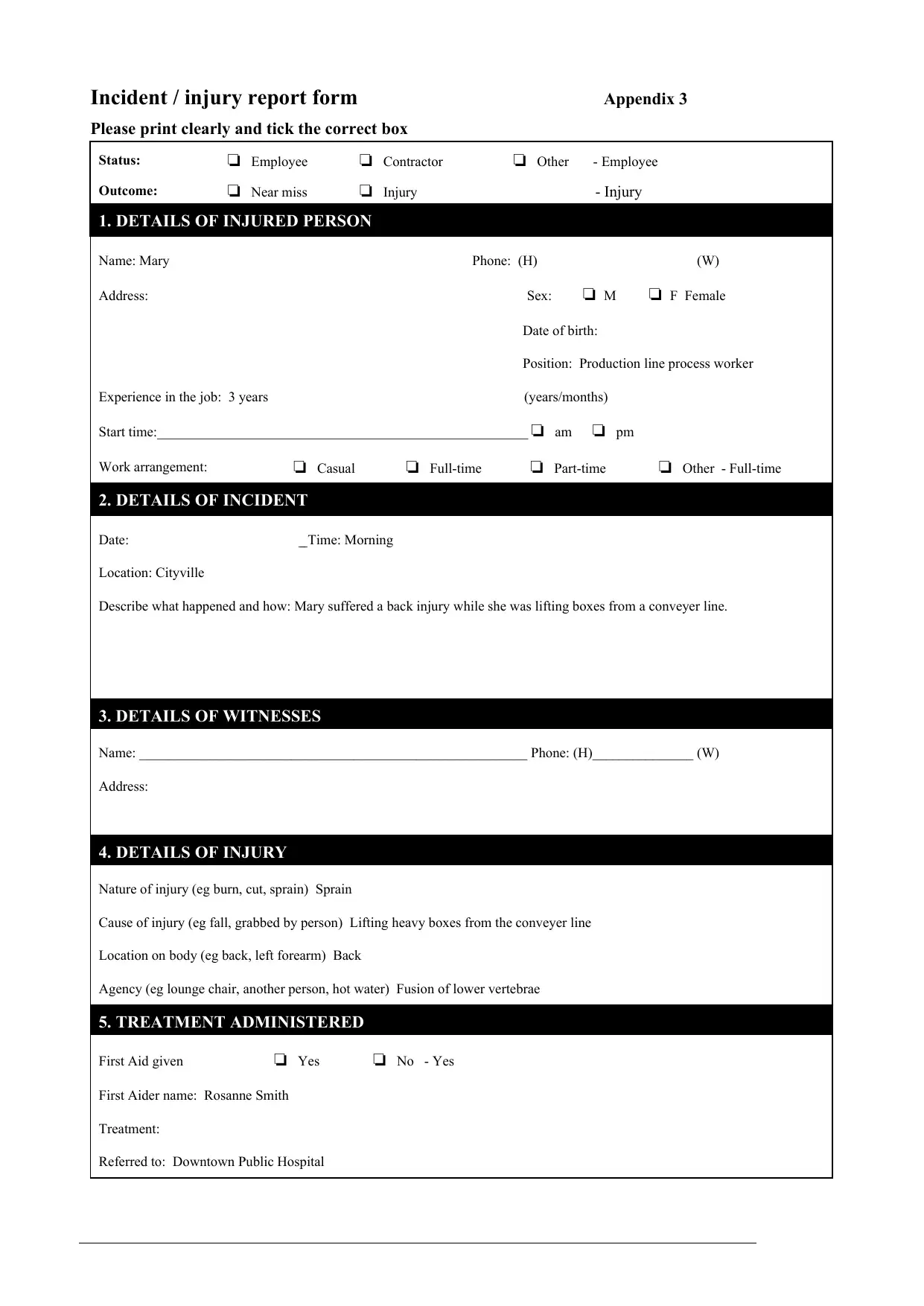
Incident / injury report form Appendix 3
Please print clearly and tick the correct box
Status: Employee Contractor Other - Employee
Outcome: Near miss Injury - Injury
1. DETAILS OF INJURED PERSON
Name: Mary Phone: (H) (W)
Address: Sex: M F Female
Date of birth:
Position: Production line process worker
Experience in the job: 3 years (years/months)
Start time:______________________________________________________ am pm
Work arrangement: Casual Full-time Part-time Other - Full-time
2. DETAILS OF INCIDENT
Date: __Time: Morning
Location: Cityville
Describe what happened and how: Mary suffered a back injury while she was lifting boxes from a conveyer line.
3. DETAILS OF WITNESSES
Name: ________________________________________________________ Phone: (H)_______________ (W)
Address:
4. DETAILS OF INJURY
Nature of injury (eg burn, cut, sprain) Sprain
Cause of injury (eg fall, grabbed by person) Lifting heavy boxes from the conveyer line
Location on body (eg back, left forearm) Back
Agency (eg lounge chair, another person, hot water) Fusion of lower vertebrae
5. TREATMENT ADMINISTERED
First Aid given Yes No - Yes
First Aider name: Rosanne Smith
Treatment:
Referred to: Downtown Public Hospital
Please print clearly and tick the correct box
Status: Employee Contractor Other - Employee
Outcome: Near miss Injury - Injury
1. DETAILS OF INJURED PERSON
Name: Mary Phone: (H) (W)
Address: Sex: M F Female
Date of birth:
Position: Production line process worker
Experience in the job: 3 years (years/months)
Start time:______________________________________________________ am pm
Work arrangement: Casual Full-time Part-time Other - Full-time
2. DETAILS OF INCIDENT
Date: __Time: Morning
Location: Cityville
Describe what happened and how: Mary suffered a back injury while she was lifting boxes from a conveyer line.
3. DETAILS OF WITNESSES
Name: ________________________________________________________ Phone: (H)_______________ (W)
Address:
4. DETAILS OF INJURY
Nature of injury (eg burn, cut, sprain) Sprain
Cause of injury (eg fall, grabbed by person) Lifting heavy boxes from the conveyer line
Location on body (eg back, left forearm) Back
Agency (eg lounge chair, another person, hot water) Fusion of lower vertebrae
5. TREATMENT ADMINISTERED
First Aid given Yes No - Yes
First Aider name: Rosanne Smith
Treatment:
Referred to: Downtown Public Hospital
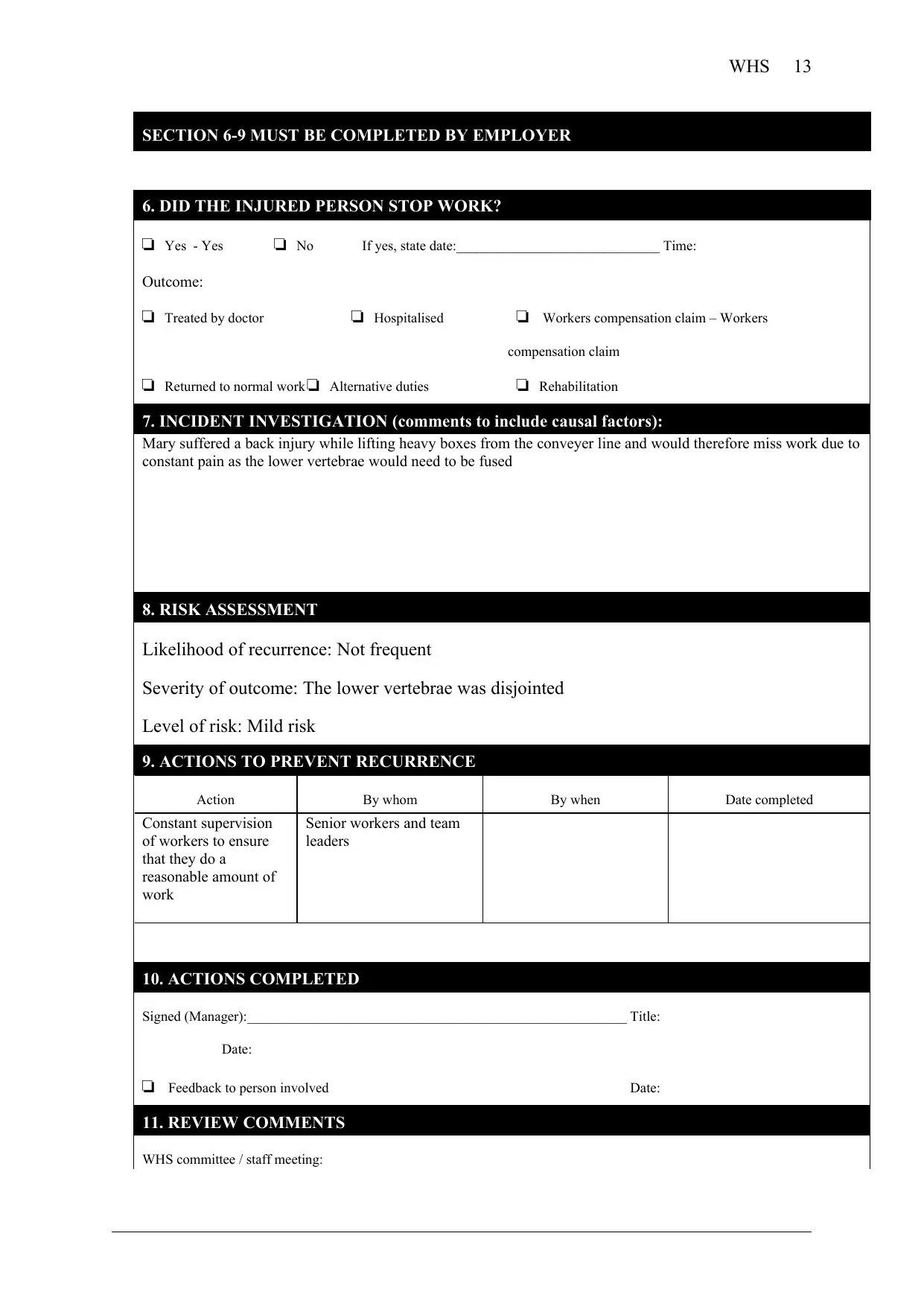
WHS 13
SECTION 6-9 MUST BE COMPLETED BY EMPLOYER
6. DID THE INJURED PERSON STOP WORK?
Yes - Yes No If yes, state date:______________________________ Time:
Outcome:
Treated by doctor Hospitalised Workers compensation claim – Workers
compensation claim
Returned to normal work Alternative duties Rehabilitation
7. INCIDENT INVESTIGATION (comments to include causal factors):
Mary suffered a back injury while lifting heavy boxes from the conveyer line and would therefore miss work due to
constant pain as the lower vertebrae would need to be fused
8. RISK ASSESSMENT
Likelihood of recurrence: Not frequent
Severity of outcome: The lower vertebrae was disjointed
Level of risk: Mild risk
9. ACTIONS TO PREVENT RECURRENCE
Action By whom By when Date completed
Constant supervision
of workers to ensure
that they do a
reasonable amount of
work
Senior workers and team
leaders
10. ACTIONS COMPLETED
Signed (Manager):_______________________________________________________ Title:
Date:
Feedback to person involved Date:
11. REVIEW COMMENTS
WHS committee / staff meeting:
SECTION 6-9 MUST BE COMPLETED BY EMPLOYER
6. DID THE INJURED PERSON STOP WORK?
Yes - Yes No If yes, state date:______________________________ Time:
Outcome:
Treated by doctor Hospitalised Workers compensation claim – Workers
compensation claim
Returned to normal work Alternative duties Rehabilitation
7. INCIDENT INVESTIGATION (comments to include causal factors):
Mary suffered a back injury while lifting heavy boxes from the conveyer line and would therefore miss work due to
constant pain as the lower vertebrae would need to be fused
8. RISK ASSESSMENT
Likelihood of recurrence: Not frequent
Severity of outcome: The lower vertebrae was disjointed
Level of risk: Mild risk
9. ACTIONS TO PREVENT RECURRENCE
Action By whom By when Date completed
Constant supervision
of workers to ensure
that they do a
reasonable amount of
work
Senior workers and team
leaders
10. ACTIONS COMPLETED
Signed (Manager):_______________________________________________________ Title:
Date:
Feedback to person involved Date:
11. REVIEW COMMENTS
WHS committee / staff meeting:
Secure Best Marks with AI Grader
Need help grading? Try our AI Grader for instant feedback on your assignments.

WHS 14
Reviewed by site Manager (signed):_________________________________________ Date:
Reviewed by Health & Safety Rep.(signed):___________________________________ Date:
Reviewed by site Manager (signed):_________________________________________ Date:
Reviewed by Health & Safety Rep.(signed):___________________________________ Date:
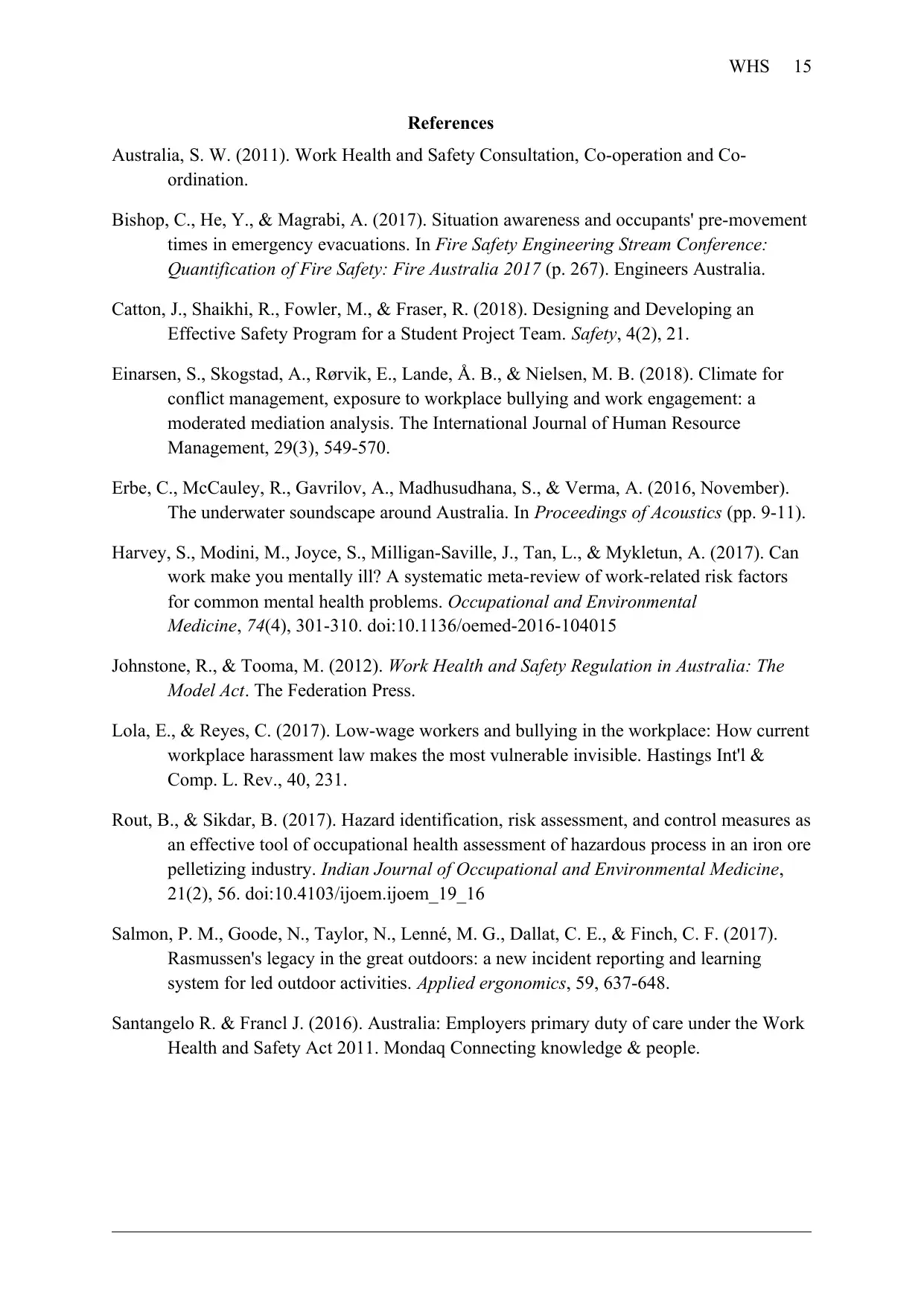
WHS 15
References
Australia, S. W. (2011). Work Health and Safety Consultation, Co-operation and Co-
ordination.
Bishop, C., He, Y., & Magrabi, A. (2017). Situation awareness and occupants' pre-movement
times in emergency evacuations. In Fire Safety Engineering Stream Conference:
Quantification of Fire Safety: Fire Australia 2017 (p. 267). Engineers Australia.
Catton, J., Shaikhi, R., Fowler, M., & Fraser, R. (2018). Designing and Developing an
Effective Safety Program for a Student Project Team. Safety, 4(2), 21.
Einarsen, S., Skogstad, A., Rørvik, E., Lande, Å. B., & Nielsen, M. B. (2018). Climate for
conflict management, exposure to workplace bullying and work engagement: a
moderated mediation analysis. The International Journal of Human Resource
Management, 29(3), 549-570.
Erbe, C., McCauley, R., Gavrilov, A., Madhusudhana, S., & Verma, A. (2016, November).
The underwater soundscape around Australia. In Proceedings of Acoustics (pp. 9-11).
Harvey, S., Modini, M., Joyce, S., Milligan-Saville, J., Tan, L., & Mykletun, A. (2017). Can
work make you mentally ill? A systematic meta-review of work-related risk factors
for common mental health problems. Occupational and Environmental
Medicine, 74(4), 301-310. doi:10.1136/oemed-2016-104015
Johnstone, R., & Tooma, M. (2012). Work Health and Safety Regulation in Australia: The
Model Act. The Federation Press.
Lola, E., & Reyes, C. (2017). Low-wage workers and bullying in the workplace: How current
workplace harassment law makes the most vulnerable invisible. Hastings Int'l &
Comp. L. Rev., 40, 231.
Rout, B., & Sikdar, B. (2017). Hazard identification, risk assessment, and control measures as
an effective tool of occupational health assessment of hazardous process in an iron ore
pelletizing industry. Indian Journal of Occupational and Environmental Medicine,
21(2), 56. doi:10.4103/ijoem.ijoem_19_16
Salmon, P. M., Goode, N., Taylor, N., Lenné, M. G., Dallat, C. E., & Finch, C. F. (2017).
Rasmussen's legacy in the great outdoors: a new incident reporting and learning
system for led outdoor activities. Applied ergonomics, 59, 637-648.
Santangelo R. & Francl J. (2016). Australia: Employers primary duty of care under the Work
Health and Safety Act 2011. Mondaq Connecting knowledge & people.
References
Australia, S. W. (2011). Work Health and Safety Consultation, Co-operation and Co-
ordination.
Bishop, C., He, Y., & Magrabi, A. (2017). Situation awareness and occupants' pre-movement
times in emergency evacuations. In Fire Safety Engineering Stream Conference:
Quantification of Fire Safety: Fire Australia 2017 (p. 267). Engineers Australia.
Catton, J., Shaikhi, R., Fowler, M., & Fraser, R. (2018). Designing and Developing an
Effective Safety Program for a Student Project Team. Safety, 4(2), 21.
Einarsen, S., Skogstad, A., Rørvik, E., Lande, Å. B., & Nielsen, M. B. (2018). Climate for
conflict management, exposure to workplace bullying and work engagement: a
moderated mediation analysis. The International Journal of Human Resource
Management, 29(3), 549-570.
Erbe, C., McCauley, R., Gavrilov, A., Madhusudhana, S., & Verma, A. (2016, November).
The underwater soundscape around Australia. In Proceedings of Acoustics (pp. 9-11).
Harvey, S., Modini, M., Joyce, S., Milligan-Saville, J., Tan, L., & Mykletun, A. (2017). Can
work make you mentally ill? A systematic meta-review of work-related risk factors
for common mental health problems. Occupational and Environmental
Medicine, 74(4), 301-310. doi:10.1136/oemed-2016-104015
Johnstone, R., & Tooma, M. (2012). Work Health and Safety Regulation in Australia: The
Model Act. The Federation Press.
Lola, E., & Reyes, C. (2017). Low-wage workers and bullying in the workplace: How current
workplace harassment law makes the most vulnerable invisible. Hastings Int'l &
Comp. L. Rev., 40, 231.
Rout, B., & Sikdar, B. (2017). Hazard identification, risk assessment, and control measures as
an effective tool of occupational health assessment of hazardous process in an iron ore
pelletizing industry. Indian Journal of Occupational and Environmental Medicine,
21(2), 56. doi:10.4103/ijoem.ijoem_19_16
Salmon, P. M., Goode, N., Taylor, N., Lenné, M. G., Dallat, C. E., & Finch, C. F. (2017).
Rasmussen's legacy in the great outdoors: a new incident reporting and learning
system for led outdoor activities. Applied ergonomics, 59, 637-648.
Santangelo R. & Francl J. (2016). Australia: Employers primary duty of care under the Work
Health and Safety Act 2011. Mondaq Connecting knowledge & people.
1 out of 15
Related Documents
Your All-in-One AI-Powered Toolkit for Academic Success.
+13062052269
info@desklib.com
Available 24*7 on WhatsApp / Email
![[object Object]](/_next/static/media/star-bottom.7253800d.svg)
Unlock your academic potential
© 2024 | Zucol Services PVT LTD | All rights reserved.





